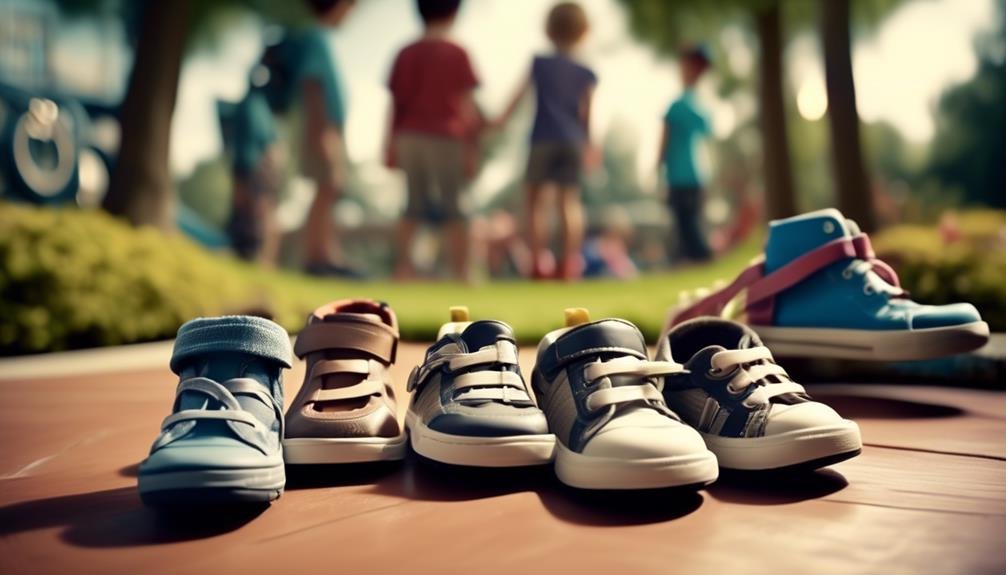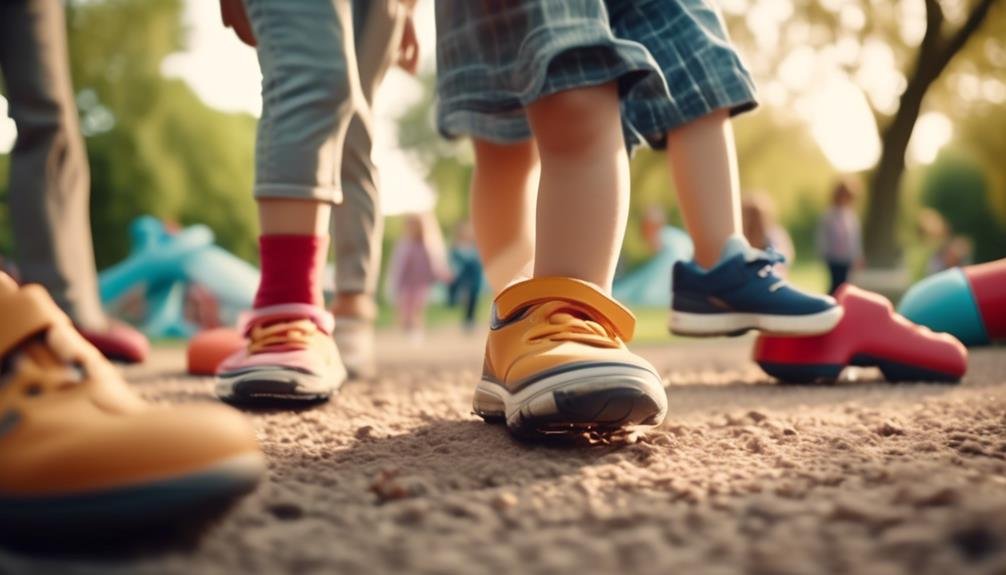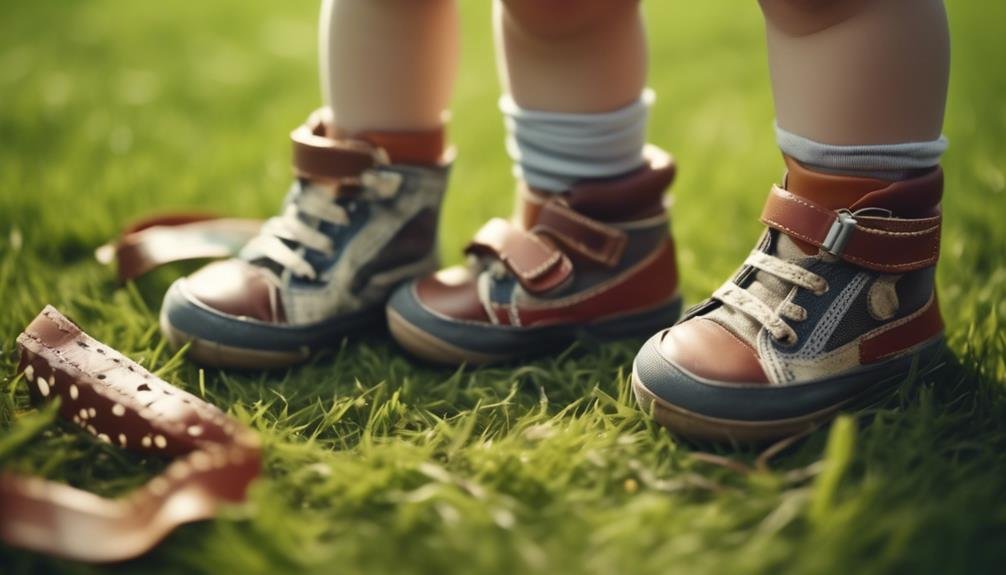Childrens Foot Growth
How to Select the Perfect Shoes for Your Child's Healthy Foot Development

Selecting the appropriate footwear for a child is a critical component of fostering healthy foot development, a factor that can have a substantial impact on their overall posture and mobility throughout life.
As a professional in the field, it is essential to consider that children's feet are not merely smaller versions of adults'; they are uniquely flexible and pliable, requiring shoes that accommodate their growth and developmental needs. The appropriate shoe must offer a harmonious balance of support and flexibility, ensuring comfort while allowing for the natural movement essential to developing muscles and tendons.
In the quest for the ideal children's shoe, it is imperative to understand the nuanced variables that contribute to optimal foot health, such as the right fit, adequate room for growth, and material breathability.
To provide a comprehensive overview, we will explore the key features that define good footwear for children and the common pitfalls that can adversely affect their foot development. The significance of these considerations cannot be understated, as the choices made during these formative years lay the groundwork for a child's future gait and posture.
Key Takeaways
- Proper footwear is crucial for optimal foot health and development in children.
- Well-fitted shoes provide support, flexibility, and promote a healthy gait.
- Gait analysis can help identify irregular walking patterns and guide shoe selection.
- Good shoes should have adequate arch support, room for growth, secure fastening, and breathable materials.
Understanding Pediatric Foot Development
The development of a child's foot is a complex process that involves changes in shape, structure, and function, which are crucial to consider when selecting appropriate footwear. This intricate progression dictates not only the immediate comfort of the child but also the long-term health of their feet.
Initially, an infant's foot is padded with fat and is highly flexible. As children grow, these fat pads diminish, and the bones begin to ossify, leading to more defined foot structures.
During this time, gait patterns also emerge and evolve. Gait, the manner or style of walking, can be influenced by the fit and design of a child's shoe. Poorly fitted shoes may lead to abnormal gait patterns, which can have a ripple effect on overall posture and musculoskeletal health. Hence, understanding and monitoring a child's walking style is imperative when considering footwear.
Arch development is another vital aspect of foot growth. The arch of a child's foot typically develops fully by the age of 6 to 8 years. Shoes should provide support without constraining the natural formation of the arch. Proper support promotes healthy arch development, which is essential for balance, weight distribution, and shock absorption.
Importance of Proper Footwear
Proper footwear serves as the cornerstone for maintaining optimal foot health and ensuring the correct development of a child's feet. A well-fitted shoe provides the necessary support and flexibility, which are pivotal during the various stages of growth.
As we explore the essentials of shoe fit, we will underscore their role in laying the foundation for a lifetime of healthy foot function.
Foot Health Foundations
Ensuring the selection of appropriate footwear is fundamental to cultivating healthy foot development and preventing a myriad of podiatric complications. Proper shoes provide essential arch support, crucial for maintaining the foot's natural structure and function. Without this support, children are at risk of developing flat feet, which can lead to other alignment issues and discomfort.
Additionally, gait analysis is a valuable tool in choosing the right footwear. This assessment helps identify any irregular walking patterns or misalignments that could be corrected or accommodated with the correct type of shoes.
Shoe Fit Essentials
Selecting footwear that fits correctly is paramount for the structural integrity of developing feet, influencing posture, balance, and overall musculoskeletal health. Measuring techniques that consider both length and width ensure that shoes provide adequate space without constricting growth. Proper arch support is also critical, as it fosters natural foot development and aids in preventing flat feet or overpronation.
| Essential Factor | Why It Matters |
|---|---|
| Room for Growth | Allows for natural foot expansion and toe movement, which is crucial for balance and walking. |
| Secure Fit | Prevents excessive foot movement inside the shoe that can lead to blisters and instability. |
| Arch Support | Supports the foot's natural arch, promoting a healthy gait and reducing the risk of developmental issues. |
Appropriate footwear is a cornerstone in supporting a child's foot health and overall well-being.
Key Features of Good Shoes

When choosing footwear, it is essential to consider several key features that promote healthy foot development and prevent injury. The design and construction of children's shoes should offer support, flexibility, and comfort to accommodate their active lifestyles and growing feet.
- Sole Thickness and Flexibility
- Sole thickness should be sufficient to protect the foot from rough terrain but not so thick as to impede natural foot movement.
- Flexibility in the sole allows for proper foot flexion, crucial during walking or running.
- Proper Arch Support
- Arch relevance cannot be overstated; shoes should provide support without being overly restrictive, allowing the child's arch to develop naturally.
- A contoured insole can help distribute pressure evenly across the foot.
Other features to consider include:
- Breathable Materials: Ensure the shoes are made from materials that allow for air circulation, preventing moisture build-up.
- Room for Growth: There should be enough space to accommodate growing feet without being too large, which could lead to tripping.
- Secure Fastenings: Shoes should have laces, Velcro, or other fastenings to hold the foot firmly and prevent slipping inside the shoe.
Selecting shoes with these characteristics will contribute to the overall well-being and healthy development of your child's feet.
Assessing Shoe Size and Fit
Having discussed the critical features of children's footwear, it is equally important to address how to accurately assess shoe size and fit for optimal foot development. Measuring techniques for children's shoes should be precise to ensure a snug fit without constricting growth. One common method is the use of a Brannock device or a printable shoe size chart specific to children's sizes.
When measuring, ensure the child stands with full weight on the feet, and measure both feet as sizes may differ. The longest toe should have about a thumb's width of space from the shoe's end, providing a proper growth allowance. This space accommodates natural movement and growth spurts, preventing the shoes from becoming too tight too quickly.
Check the width as well as the length, as proper fit in both dimensions is vital for comfort and stability. The shoe should be snug but not tight, with enough room to wiggle toes freely. It's advisable to re-measure a child's feet every few months as they grow rapidly, and to reassess both the shoe size and fit accordingly.
Selecting the Right Material

The composition of footwear materials plays a pivotal role in ensuring both the comfort and proper development of a child's foot. When selecting shoes for your child, it's crucial to consider factors beyond the latest style trends to prevent foot allergies and ensure optimal foot health.
- Breathable Fabrics:
- Natural materials such as cotton or leather allow for air circulation, reducing moisture and the likelihood of fungal infections.
- Mesh panels can provide additional airflow, especially in athletic footwear.
- Hypoallergenic Options:
- Consider shoes made from hypoallergenic materials to prevent allergic reactions and skin irritations.
- Seek out brands that specifically cater to sensitive skin and foot allergies.
Materials should also provide flexibility for natural foot movements while offering adequate support. Stiff materials can restrict growth and movement, leading to developmental issues, while excessively soft materials may not provide the necessary support for a growing child's foot. Therefore, finding a balance between flexibility, support, and the right materials is essential for your child's foot health and development.
Always prioritize function and fit over fashion, but bear in mind that many brands now offer stylish options without compromising on quality and comfort.
Flexibility and Support Considerations
Understanding the critical role of material choice, it is equally important to consider the balance between flexibility and support that footwear provides for the healthy development of a child's foot. Shoes that are too rigid can impede natural foot movement, while those lacking support may contribute to developmental issues. Material breathability is a key factor in maintaining foot health, preventing moisture buildup that can lead to fungal infections.
Arch adaptation refers to the shoe's ability to accommodate the natural arch of a child's foot. A properly designed shoe should offer support without being overly constrictive, allowing the foot to develop strength and stability naturally.
To help guide parents in their selection, consider the following table which outlines the essential aspects of flexibility and support:
| Feature | Importance for Development | Consideration |
|---|---|---|
| Sole Flexibility | Allows natural foot movement | Look for soles that bend with the foot |
| Arch Support | Prevents flatfoot and promotes balance | Ensure moderate arch support tailored to the child's foot |
| Heel Counter | Stabilizes the heel | Should be firm but not restrictive |
| Material Breathability | Prevents moisture and promotes comfort | Choose materials that allow air circulation |
| Toe Box Space | Enables toe movement and growth | Ensure ample room for toes without excess space |
Selecting the right shoe with a balance of these attributes will contribute to healthy foot development and a comfortable fit for your child.
Frequently Asked Questions
How Can I Tell if My Child Is Experiencing Discomfort or Pain Due to Their Current Footwear?
To discern if a child's footwear causes discomfort, observe foot signs such as redness or blisters, and monitor behavior indicating pain like limping or reluctance to walk. Seek professional advice if needed.
Are There Any Specific Exercises or Activities That Can Promote Healthy Foot Development in Children?
Yes, activities such as walking barefoot to reap its benefits and engaging in toe games can enhance muscular strength and contribute to the overall healthy development of a child's feet.
How Often Should I Replace My Child's Shoes Due to Natural Foot Growth or Wear and Tear?
Children's shoes, the tireless chariots of playtime, typically require replacement every three to six months due to rapid growth and wear. Growth tracking ensures a suitable shoe lifespan for optimal foot health.
Can My Child Still Wear Decorative or Character-Themed Shoes Without Compromising Their Foot Health?
Character-themed shoes can be worn occasionally without compromising foot health, provided they offer proper support. Frequent use, however, should not come at the expense of adequate function, risking fashion compromise over orthopedic benefit.
Is It Advisable to Use Second-Hand Shoes, and if So, What Precautions Should I Take?
Navigating the terrain of second-hand footwear demands caution; prioritize shoe sanitization and material considerations to ensure the integrity and hygiene of pre-loved shoes for your child's continued well-being and comfort.
Conclusion
In conclusion, appropriate footwear is paramount in safeguarding the integrity of a child's foot development.
A striking statistic reveals that over 70% of foot problems in adults stem from ill-fitting shoes during childhood, highlighting the long-term implications of early footwear choices.
It is imperative that caregivers prioritize the selection of well-fitted, suitable shoes to ensure the health and proper growth of a child's feet, thereby reducing the risk of future podiatric complications.
